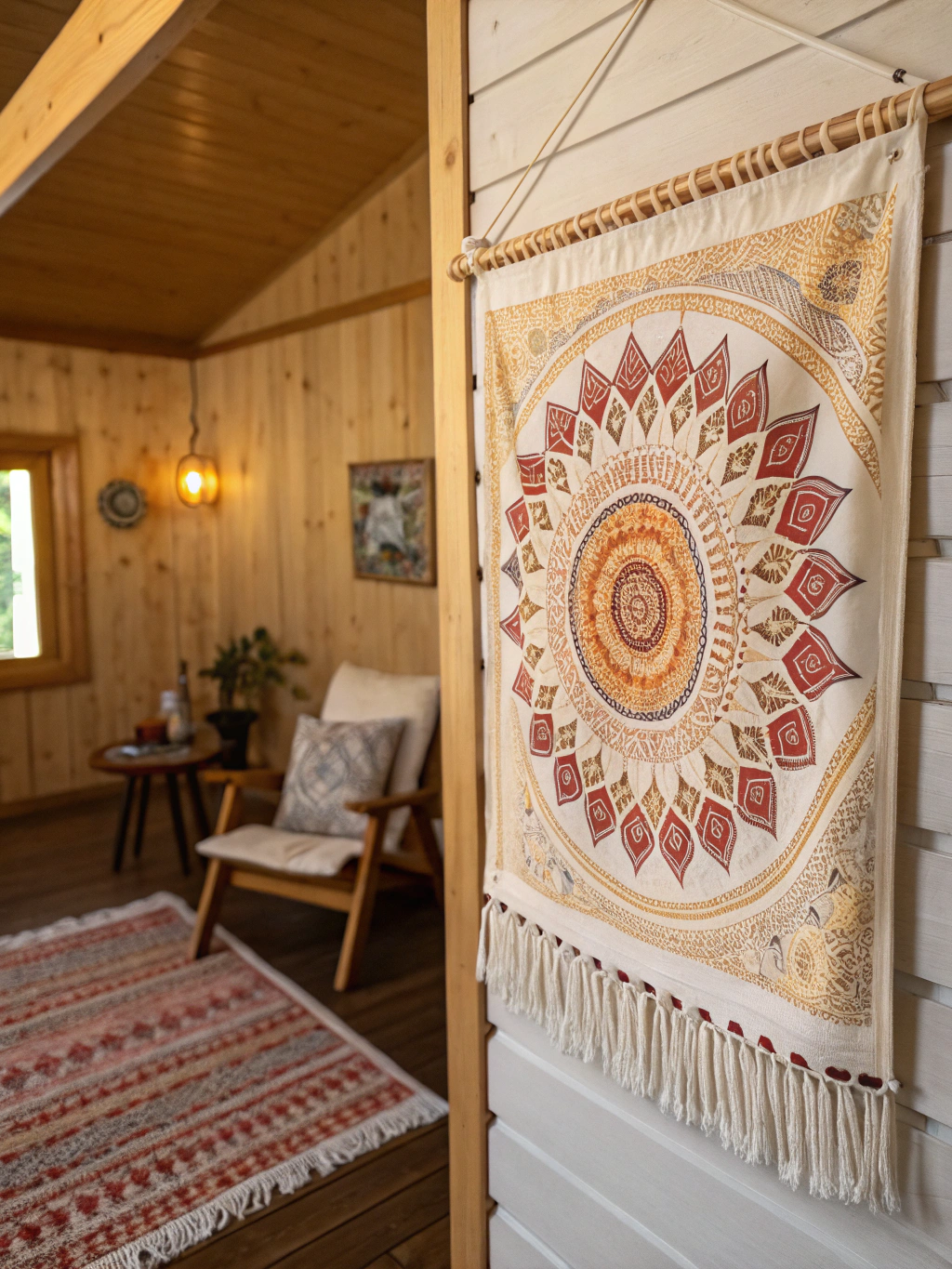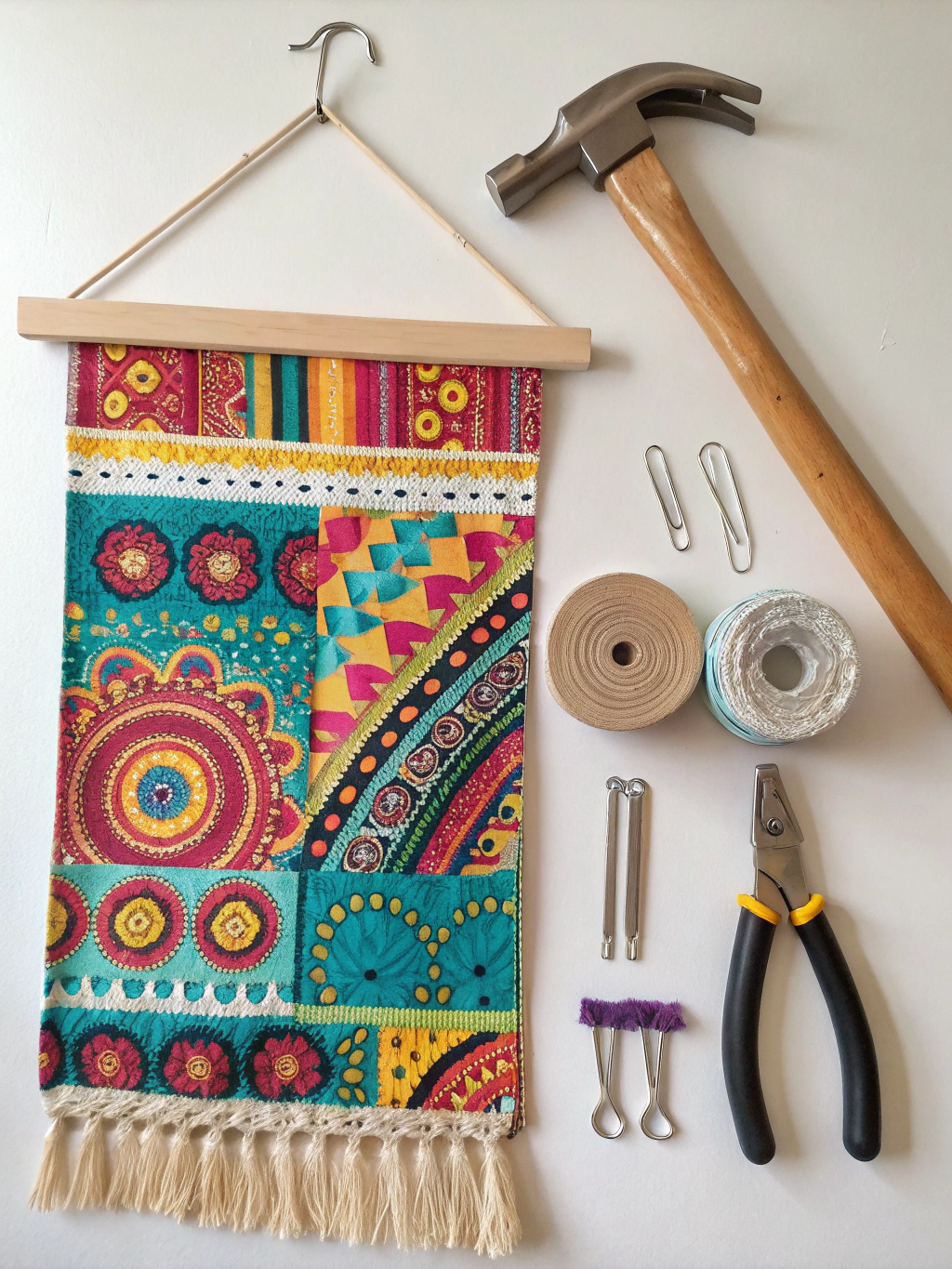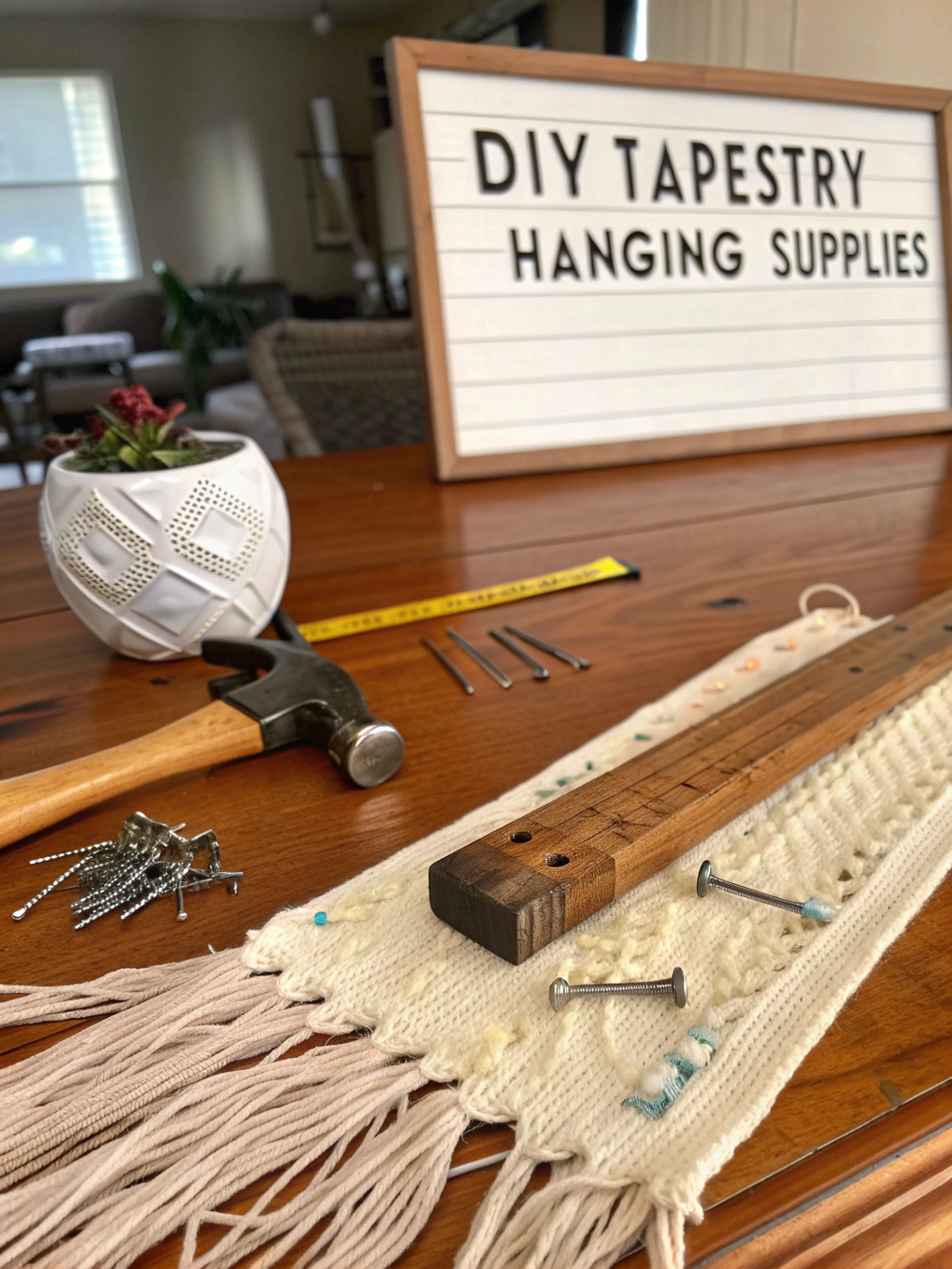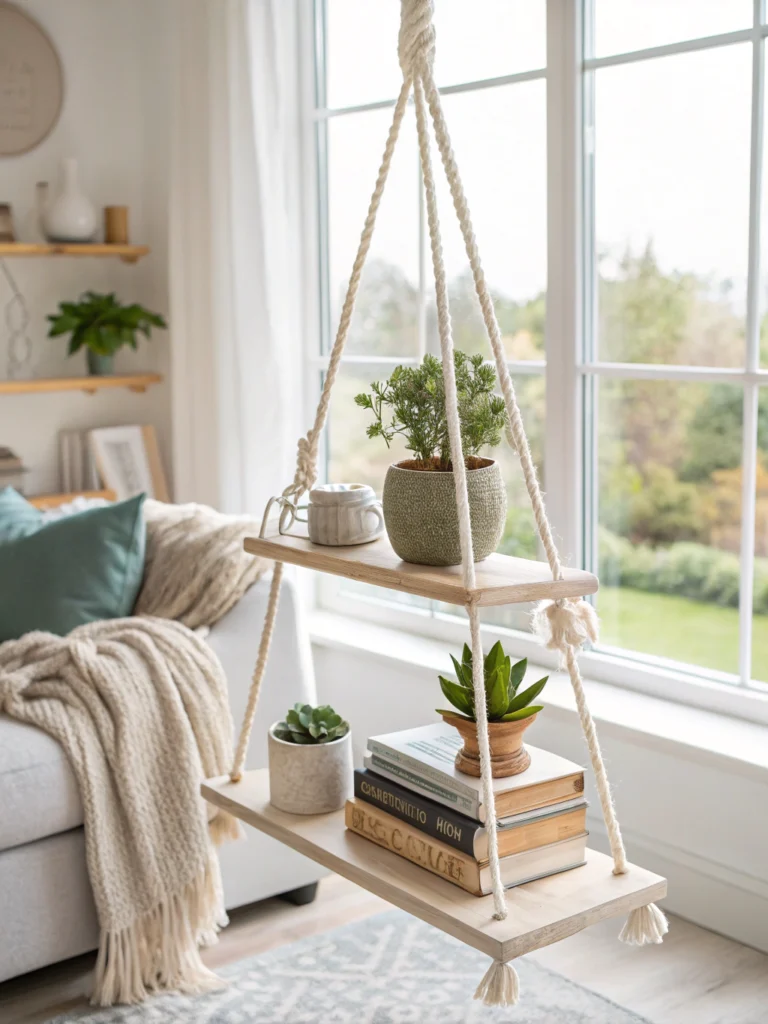Introduction
Ever stared at a beautiful tapestry, brimming with color and texture, only to feel a wave of uncertainty about how to actually get it on your wall? You’re not alone! Many home improvement enthusiasts find that mastering DIY tapestry hanging can seem a bit daunting at first. Will it be straight? Will it damage the wall? Will it even stay up? These are common worries that can turn an exciting decor project into a source of stress. But fear not! Transforming your space with a stunning fabric art piece is easier than you think.
This comprehensive guide will walk you through 5 simple steps to flawlessly hang your tapestry, turning that blank wall into a captivating focal point. We’ll cover everything from choosing the right tools to ensuring a perfectly level display, so you can approach your next DIY tapestry hanging project with confidence and achieve professional-looking results every time. Let’s get those walls looking fabulous!
Table of Contents

Caption: Transform your room with a beautifully hung tapestry, a simple yet impactful DIY project.
What You’ll Need for Your DIY Tapestry Hanging Project
Before you dive into the actual hanging process, let’s gather all the necessary materials and tools. Being prepared is half the battle in any DIY endeavor, and DIY tapestry hanging is no exception. Having everything at your fingertips will make the process smoother and much more enjoyable. You might find you already have many of these items around your home, especially if you’re a seasoned DIYer.

Caption: Gather these essential tools and materials before you begin your DIY tapestry hanging project.
Here’s a list of what you’ll typically need:
- Your Tapestry: Of course! Make sure it’s clean and ironed (if the fabric allows) before you start. Wrinkles can detract from the final look. Check care labels first; some delicate materials might need steaming instead of direct ironing.
- Measuring Tape: Crucial for finding the center of your wall and ensuring your tapestry is positioned exactly where you want it. Accuracy here prevents a lopsided display.
- Pencil: For lightly marking your measurements on the wall. Use one that erases easily so you don’t leave permanent marks.
- Level: A spirit level or laser level will be your best friend for ensuring your tapestry hangs perfectly straight. Even a slight tilt can be noticeable.
- Hammer or Drill (depending on your chosen hanging method): For securing nails, screws, or other hanging hardware into the wall. If you’re drilling, make sure you have the correct drill bit size for your screws and wall type.
- Hanging Hardware: This is where you have options! Common choices include:
- Nails or Tacks: Simple for lightweight tapestries, but might not be suitable for all wall types or heavier pieces. Small, thin nails are less damaging.
- Velcro Strips (Heavy-Duty Hook and Loop Fasteners): A great no-damage option, especially for renters. Ensure you get a brand strong enough to hold the tapestry’s weight.
- Command Strips (Picture Hanging Strips): Another damage-free favorite. Choose strips rated for the weight of your tapestry.
- Curtain Rod with Brackets: Ideal for larger, heavier tapestries or if you want a more formal, draped look. This method often involves sewing a rod pocket onto the back of the tapestry.
- Wooden Dowel or Plank: You can attach the tapestry to a piece of wood and then hang the wood on the wall. This can add a rustic or modern touch.
- Tapestry Clips or Clamps: These can grip the top edge of the tapestry and hang from nails or hooks. They add a decorative element themselves.
- Wall Anchors (if needed): If you’re hanging a heavy tapestry on drywall and not hitting a stud, wall anchors are essential to prevent the screws from pulling out.
- Safety Goggles: Always a good idea when hammering or drilling to protect your eyes from dust and debris.
- Fabric Clips or Pins (Optional): Useful for temporarily holding the tapestry in place while you work, or for some specific hanging methods.
- Stepladder or Stool: To safely reach the desired hanging height. Ensure it’s stable before you climb.
Choosing the right hanging hardware is one of the key “DIY tapestry hanging tips, How to hang a tapestry easily, Tapestry wall hanging techniques“. Consider the weight and size of your tapestry, your wall type (drywall, plaster, brick), and whether you need a temporary, damage-free solution or a more permanent fixture. For delicate or valuable tapestries, a conservation-friendly method that distributes weight evenly is best.
Step-by-Step Guide to Perfect DIY Tapestry Hanging
Now that you’ve gathered your supplies, it’s time to get that beautiful tapestry up on your wall! Follow these five simple steps for a flawless finish. We’ll break down each part of the process, making your DIY tapestry hanging experience a breeze.
Step 1: Prepare Your Tapestry and Choose the Location
Before you even think about touching the wall, ensure your tapestry is ready. If it’s been folded or stored, it likely has creases. Most tapestries can be gently ironed on a low heat setting, preferably on the reverse side or with a pressing cloth between the iron and the fabric to prevent scorching or shine. Always check the care label first! Some delicate materials might require steaming. A wrinkle-free tapestry will hang much more beautifully and look more professional.
Next, decide where you want to hang it. Consider the room’s focal points, furniture arrangement, and lighting. Do you want it centered above a sofa, bed, or console table? Or perhaps as a standalone statement piece on a large, empty wall? Use your measuring tape to visualize the space it will occupy. Hold the tapestry up (you might need a helper for larger ones) to get a feel for its impact in different spots. Think about eye level – generally, the center of the artwork should be around 57-60 inches from the floor, but this can vary based on ceiling height and personal preference. This initial planning is crucial for a successful DIY tapestry hanging outcome.
Once you’ve picked the perfect spot, lightly mark the desired top center point or top corners on the wall with your pencil. These initial marks will guide your further measurements. Don’t press too hard; you’ll want to erase these later. This stage is all about envisioning the final result and making sure it aligns with your overall room decor.

Caption: Step 1: Ensure your tapestry is wrinkle-free and select the ideal spot on your wall.
Step 2: Measure and Mark Precisely
Accuracy is key in this step. Sloppy measurements can lead to a crooked or off-center tapestry, which can be incredibly frustrating after all your hard work. Start by measuring the width of your tapestry. Divide this number by two to find its center. Now, go to your chosen wall location. If you’re centering the tapestry on a wall or above furniture, measure the width of that wall space or furniture piece, find its center, and mark it lightly with your pencil at the desired height.
Align the center of your tapestry with the center mark on the wall. From this central point on the wall, measure out half the tapestry’s width to the left and mark it, then do the same to the right and mark it. These two outer marks indicate where the top corners of your tapestry will be. Use your level to ensure these two marks are perfectly horizontal. Place the level across the two marks; if the bubble isn’t centered, adjust one of the marks slightly up or down until it is. This step ensures your DIY tapestry hanging efforts result in a straight, professional look.
If you’re using a rod or dowel, your marks will be for the brackets. If you’re using Velcro or Command Strips, these marks will guide where you place the top edge of the strips. Take your time here – double-check all your measurements. Remember the old adage: “Measure twice, cut once” (or in this case, “Measure twice, hang once!”). This meticulous approach is fundamental to “Tapestry wall hanging techniques” that yield the best results.
Caption: Step 2: Use a measuring tape and level to accurately mark the tapestry’s position.
Step 3: Install Your Chosen Hanging Hardware
This is where your preparedness from the “What You’ll Need” section comes into play. The installation method will vary significantly based on the hardware you’ve selected.
- For Nails or Tacks: If your tapestry is lightweight and you’ve opted for simple nails or tacks, gently hammer them into your marked spots. Use enough nails along the top edge to support the weight evenly and prevent sagging – typically one at each corner and a few in between for wider tapestries. Ensure they are hammered in straight and securely.
- For Velcro Strips or Command Strips: This is often the answer to “How to hang a tapestry easily” without damaging walls. Cut the Velcro or Command Strips to the desired lengths. Typically, you’ll run a strip along the entire top edge of the tapestry’s back, and possibly down the sides for larger or heavier pieces. Peel off the backing from one side of the strips and firmly press them onto the back of the tapestry, ensuring good adhesion. Then, peel off the wall-side backing and carefully press the tapestry onto the wall, aligning its top edge with your level pencil marks. Press firmly along the strip locations for the recommended time (usually 30-60 seconds) to ensure a strong bond.
- For a Curtain Rod or Dowel: You’ll first need to attach the brackets to the wall at your marked locations. Use your drill and screws for this. If you’re not drilling into a stud, remember to use wall anchors for support. Once the brackets are secure, slide the rod (with the tapestry already on it, if it has a rod pocket) into the brackets. If your tapestry doesn’t have a rod pocket, you might need to sew one on, or use curtain clips to attach the tapestry to the rod.
- For a Wooden Plank: Attach your tapestry to the wooden plank first. You can do this by stapling the fabric to the back of the plank, or by using decorative tacks on the front. Then, hang the plank on the wall using D-rings and wire, sawtooth hangers, or by screwing it directly into studs or anchors.
- For Tapestry Clips: Hammer in small nails or install hooks at your marked points along the top line. Then, simply clip the tapestry onto these nails/hooks. Space the clips evenly to distribute the weight and create a nice drape.
Whichever method you choose, ensure it’s appropriate for your tapestry’s weight and fabric type. Heavier tapestries require more robust support. Always prioritize safety when using tools like hammers or drills – wear those safety goggles! This step is crucial for a secure and lasting DIY tapestry hanging display.
Caption: Step 3: Carefully install your selected hanging hardware, ensuring it’s level and secure.
Step 4: Hang Your Tapestry
With your hardware in place, it’s time for the main event: hanging the tapestry! This step requires a bit of care and precision to ensure it hangs straight and smooth.
If you’ve used nails or tacks, carefully hook the top edge or corners of the tapestry onto them. Start from one corner and work your way across. If you’re using Velcro or Command Strips and haven’t already attached the tapestry to the wall (some methods involve applying strips to both surfaces separately, then joining), carefully align the top edge of the tapestry with your level guideline on the wall. Press firmly, starting from the center and moving outwards, then downwards, to ensure the strips make full contact and bond securely. Smooth out any wrinkles or bubbles as you go.
For rod-based systems, if the tapestry wasn’t already on the rod when you installed the brackets, slide the tapestry onto the rod now. Then, carefully place the rod onto the brackets. Adjust the tapestry fabric on the rod so it hangs evenly and the gathers (if any) are distributed pleasingly. If using clips, attach them to the tapestry’s top edge first, spacing them evenly, and then hook the clips onto your pre-installed nails or hooks.
Take a step back frequently during this process to check the alignment from a distance. It’s easier to make minor adjustments now than to take it all down and start over. If you have a helper, this is a good time for them to stand back and let you know if it’s looking straight. Ensure the tapestry fabric is hanging naturally, without any undue tension or pulling at any single point, which could distort the weave or image over time. This careful attention to detail is what elevates a simple DIY tapestry hanging job to a professional-looking installation.
Caption: Step 4: Gently hang the tapestry, ensuring it’s straight and the fabric falls naturally.
Step 5: Final Adjustments and Clean Up
You’re almost there! Once the tapestry is up, take a few steps back and admire your work. Look at it from different angles in the room. Is it perfectly level? Is it centered as you intended? Does the fabric hang smoothly?
Now is the time for any minor tweaks. If it’s slightly askew, gently adjust it. If you used Velcro or Command Strips, you might be able to carefully peel back a section and re-press. With nails or tacks, you might need to slightly reposition one or two. For rod systems, ensure the fabric is evenly distributed. If the bottom corners are curling or not hanging flat, you can consider adding small drapery weights sewn into the bottom hem or discreetly attached to the back. This is one of the subtle “DIY tapestry hanging tips, How to hang a tapestry easily, Tapestry wall hanging techniques” that pros use for a perfect drape.
Once you’re happy with the positioning and drape, gently erase any visible pencil marks from the wall. Tidy up your tools and any debris. Now, stand back and fully appreciate the transformation! Your successful DIY tapestry hanging project has added a unique and personal touch to your space, bringing warmth, texture, and color. It’s amazing how a piece of fabric art can completely change the ambiance of a room.
Caption: Step 5: Make any final tweaks for perfect alignment and clean up your workspace.
The Stunning Final Result of Your DIY Tapestry Hanging
And there you have it! After following these steps, your tapestry should be hanging beautifully, transforming your wall from bland to grand. This DIY tapestry hanging project not only adds a significant visual impact but also gives you the satisfaction of having done it yourself. The texture and artistry of the tapestry can now be fully appreciated, creating a cozy and inviting atmosphere or a bold statement, depending on your chosen piece.

Caption: Admire your beautifully hung tapestry – a testament to your successful DIY skills!
Whether it’s a vibrant bohemian print, a serene landscape, or an abstract design, your carefully hung tapestry is now a focal point that reflects your personal style. It’s amazing how much character a textile piece can add to a room, softening acoustics and adding a layer of sophistication or playfulness.
We’d love to see how your DIY tapestry hanging project turned out! Share your photos and any unique tips you discovered along the way in the comments below. Did you use a different hanging method? Encounter any unexpected challenges? Your experience could help fellow DIY enthusiasts!
Pro Tips for Flawless DIY Tapestry Hanging & FAQs
You’ve learned the basic steps, but let’s delve into some expert advice and frequently asked questions to ensure your DIY tapestry hanging is truly exceptional and troubleshoot any potential issues. These insights can elevate your project from good to great.
1. How do I hang a very heavy tapestry?
For heavy tapestries, distributing the weight evenly is paramount. Avoid using just a few nails or tacks, as this can strain the fabric and potentially damage your wall. The best “Tapestry wall hanging techniques” for heavy pieces often involve:
- A Sturdy Rod and Brackets: Sew a robust rod pocket onto the back of the tapestry (or reinforce an existing one) and use a strong metal or wooden rod. Ensure the brackets are screwed directly into wall studs. If studs aren’t available in the right spots, use heavy-duty drywall anchors designed for significant weight.
- A Wooden Batten/Plank System: Attach a strip of Velcro (the hook side) to a wooden batten cut slightly shorter than the tapestry’s width. Screw this batten securely to the wall (into studs or with anchors). Sew the corresponding loop side of the Velcro to the top back edge of your tapestry. This method provides continuous support along the entire top edge.
- Professional Mounting: For extremely valuable or antique heavy tapestries, consider consulting a professional textile conservator or art installer. They use specialized techniques to prevent damage and ensure longevity.
Remember to always overestimate the support needed rather than underestimate it.
2. What’s the best way “How to hang a tapestry easily” without damaging walls, especially in a rental?
This is a common concern! Thankfully, there are several excellent damage-free options for your DIY tapestry hanging:
- Heavy-Duty Command Strips (Picture Hanging Strips): These are a go-to for renters. Choose strips rated well above your tapestry’s weight. Apply them along the top edge and potentially the sides for larger pieces. Follow the package instructions carefully for application and removal to avoid paint damage.
- Velcro Strips (Hook and Loop Fasteners): Similar to Command Strips, adhesive Velcro can hold a surprising amount of weight. Opt for industrial strength if your tapestry is on the heavier side. One side adheres to the wall, the other to the tapestry.
- Tension Rods: If you’re hanging a tapestry in an alcove or between two close walls (like a hallway), a tension rod (like those used for shower curtains) can work. You’ll need to create a rod pocket in your tapestry.
- Leaning: For a more casual look, you can drape a larger tapestry over a decorative ladder or screen that leans against the wall. No holes required!
Always test adhesive strips in an inconspicuous area if you’re concerned about your paint or wallpaper.
3. My tapestry has wrinkles that won’t come out with ironing. What now?
Stubborn wrinkles can be frustrating. Here are a few tricks:
- Steaming: A garment steamer is often more effective and gentler than an iron, especially for delicate fabrics. Hang the tapestry and gently steam it, working from top to bottom. Keep the steamer moving to avoid water spots.
- Bathroom Steam Method: Hang your tapestry in the bathroom while you take a hot shower. The steam can help relax the fibers and release wrinkles. Ensure the room is well-ventilated afterward.
- Weighted Hanging: Sometimes, simply hanging the tapestry for a few days will allow gravity to pull out minor wrinkles, especially if the fabric has some weight to it. You can add temporary, light weights to the bottom hem to assist this process.
- Professional Pressing: If it’s a valuable or particularly delicate piece, consider taking it to a professional dry cleaner who offers pressing services for specialty textiles.
Always test any method on a small, inconspicuous area first. Some “[DIY tapestry hanging tips, How to hang a tapestry easily, Tapestry wall hanging techniques](https://www.fixdiy.site/holiday-diys/)” may also involve professional cleaning or pressing prior to hanging.
4. How do I clean a hung tapestry?
Regular light cleaning can keep your tapestry looking its best.
- Dusting: Use the soft brush attachment on your vacuum cleaner on its lowest suction setting. Gently brush the tapestry from top to bottom. Do this every few months.
- Spot Cleaning: For small spills, act quickly. Blot (don’t rub!) the area with a clean, white cloth. If water is safe for the fabric, use a slightly damp cloth. For tougher stains, consult the tapestry’s care instructions or a professional cleaner. Always test any cleaning solution on a hidden area first.
- Avoid Direct Sunlight: Prolonged exposure to direct sunlight can fade the colors over time. If possible, hang your tapestry in a spot that doesn’t receive harsh, direct light.
Deep cleaning should typically be left to professionals, especially for antique or delicate tapestries.
5. Can I hang a tapestry on a textured wall?
Yes, but it might require some adjustments to your DIY tapestry hanging plan.
- Adhesives (Velcro/Command Strips): These may not stick as well to heavily textured walls (like popcorn or stucco). Look for versions specifically designed for textured surfaces, or consider that they might not hold as long or as securely. A rod or nail-based system is often more reliable.
- Nails/Screws: These methods work fine on textured walls. Just ensure you’re using appropriate anchors if not hitting a stud, as the texture doesn’t affect the underlying wall structure’s holding power.
- Consider a Backing Board: For a very smooth hang on a rough wall, you could mount the tapestry to a thin piece of foam core or Masonite board first, then hang the board. This creates a flat surface for the tapestry itself.
The main challenge with textured walls is often aesthetic – ensuring the tapestry hangs straight and doesn’t look “lumpy” due to the wall texture showing through thin fabrics. Thicker tapestries or those hung with a rod tend to fare better.
We hope these advanced tips and FAQs provide even more clarity and confidence for your tapestry projects. For more innovative decor ideas and techniques, resources like HGTV’s DIY decor projects can offer further inspiration on using textiles creatively in your home. And if you’re looking for more specific holiday-themed DIYs, don’t forget to check out our other guides, like those for DIY tapestry hanging for festive seasons.
Congratulations on mastering the art of DIY tapestry hanging! We’re confident that with these steps and tips, you can tackle this project like a pro.
What are your go-to methods for hanging wall decor? Do you have any other tapestry hanging questions or brilliant tips to share? Drop a comment below – we love hearing from our community of DIYers!
If you found this guide helpful, please consider sharing it with your friends on social media or signing up for our newsletter for more DIY inspiration, expert tips, and exciting project ideas delivered straight to your inbox. Happy decorating!


